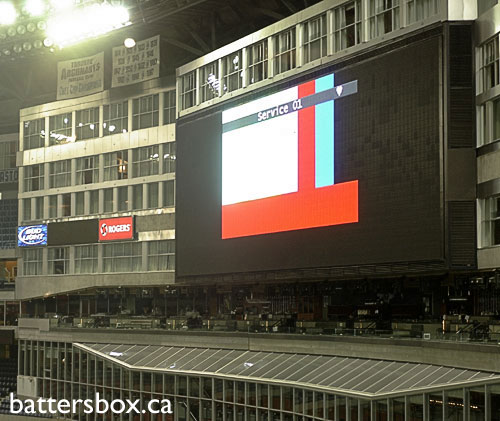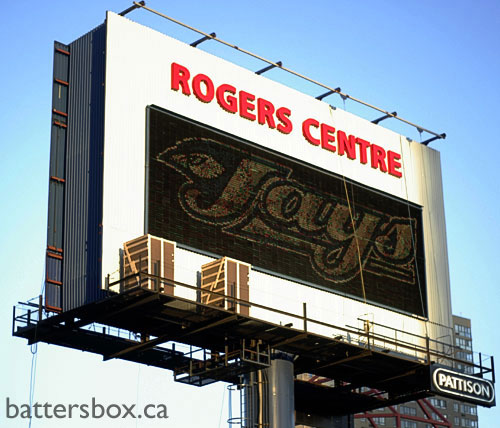The field that the Jays are actually occupying, however, and the corporate and marketing structure that supports it, are going to be downright unrecognizable in 2005 -- for the better.
Everyone knows that the Jays finally purchased Skydome in the off-season, renaming it the Rogers Centre and promising extensive renovations. Those renos will be on display tonight during the Jays' home opener against Boston, and the early buzz is that the results are spectacular.
Gone is the rock-hard Astroturf, replaced by Field Turf that's already winning the praises of the players who've seen it. When Greg Myers, who lost most of his 2004 season to a FieldTurf-induced injury in Minnesota, compliments the new surface, the Jays know they've done a good job. And although at least one Jays outfielder has reservations about the new warning track, the club doesn't seem concerned and Reed Johnson already likes it better than what came before. It might take the players some time to adjust to the bounces and speed of batted balls on the new surface, but FieldTurf is meant to be predictable and grasslike, so the learning curve should be short for the home side (and hopefully, a little steeper for visitors). Happier, healthier players are an obvious boon to the ballclub's fortunes.
Then there's the surrounding stadium improvements. For instance, the JumboTron, so outdated by the end of the last season that Sony was no longer making replacement parts for it, has been dustbinned. In its place is a slightly smaller but much more impressive scoreboard that will be brighter and more dominant than its predecessor. A hardy group of Bauxites who watched Monday's home opener on the TV in the Center's hard Rock Cafe couldn't see the new scoreboard but were impressed with the new 300-level electronic banners.
 Want to know more? Here are the first-hand comments from Rosterite Joe Drew, who sends this report while sipping a beer from the new premises:
Want to know more? Here are the first-hand comments from Rosterite Joe Drew, who sends this report while sipping a beer from the new premises:
The transformation is dramatic. The turf looks like any other field turf, but it's head and shoukders above what we had before. It looks lush. I'm watching a groundscrewman walk, and his shoes sink into the field. The warning track is also made of a turf-like substance. I'd think if they were going to make it more tennis-court like, it'd be done already.
The outfield boards are really bright; it's as if they've taken a bit of the Jumbotron and moved it down. The (not quite wraparound) scoreboards are, likewise, bright and beautiful. Every 500-level seat looks to have some red and white material on it, like the wraparound banners that also encircle the 500 and 200 level facings.
I am *really* excited. This place is gorgeous.
But there's more than just new displays. In a remarkably innovative marketing move, the Blue Jays are asking their batters to park a few home run balls. Literally. A giant display containing an actual GM car hangs invitingly over the centerfield wall like a giant Hot Wheels package. Every game, three fans will be selected as possible winners of the cars if a Blue Jay hitter strikes the glass case with a home run. The obvious downside, of course, is that you're winning a GM car. But in terms of sponsor exposure and subsequent appeal, you can't get much better than that. More importantly, it's something fresh and -- dare I say? -- leading-edge for a club that used to think a good promotional event was getting the fans to scream for free pizza.
There are other new developments less obvious to the casual fan. For one thing, the club has completely reworked its approach to its luxury boxes. The suites used to sell for $200,000 a year or $6,000 a game; last season, only three of the 150 boxes were bought for the season. So the Jays simply ripped out 70 of them, dropped the season-long price to $60,000 (and the per-game price to $2,100), and did spanking-new renovations on the remaining suites. The rewards were immediate: 14 of the boxes have already been purchased for the season, and Opening Day demand has been so strong that the club had to reopen some of the closed boxes to accommodate the demand.
 While they're lowering prices in the suites, they're raising them in the seats -- another good move. Patrick Elster, VP of Ticket Sales & Service, understands that discounting or even giving away your tickets -- as the Jays were apt to do in the past -- merely downgrades the value of your product in the eyes of the marketplace. He has raised some ticket prices and intends to raise them again. With the investment in the ballpark atmosphere, the raises surely seem justified.
While they're lowering prices in the suites, they're raising them in the seats -- another good move. Patrick Elster, VP of Ticket Sales & Service, understands that discounting or even giving away your tickets -- as the Jays were apt to do in the past -- merely downgrades the value of your product in the eyes of the marketplace. He has raised some ticket prices and intends to raise them again. With the investment in the ballpark atmosphere, the raises surely seem justified.
Attending to the atmosphere is a key feature of another big change, the team's wholesale review of its marketing approach. The Jays did a study and uncovered a remarkable fact: in the heyday of the ballclub in the early 1990s, women and men attended ballgames almost evenly; last year, the percentage had tilted to a 70-30 split in favour of males. The problem is that in most households, women have a huge impact on how entertainment dollars are spent. So the Jays are taking remarkable steps to encourage moms and women to come to the Rogers Center: a family section on the 200-level where the noises and lights are toned down, placing ads in the Life and Entertainment sections of local papers, and even buying advertising time on broadcasts of Desperate Housewives. (bselig/bselig to register if needed)
Marketing President Laurel Lindsay sums up the new approach neatly: "I can't sell performance because I can't control it. The thing I can deliver is entertainment." This approach, used by almost all successful major- and minor-league baseball clubs, is an overdue addition to the Jays' marketing efforts. A winning team sells itself; the Jays are now taking steps to sell the team if and when it's not winning.
I think the Jays will return to the .500 level this season, and with a little luck here and there, could give the Red Sox and Yankees a scare or two. But I believe the changes now underway and already being implemented in the ballpark, in the in-game experience, and in the marketing philosophy are going to have huge positive repercussions for the organization, now and down the line. The future of the on-field product is bright, but the off-field product has rarely if ever looked better.




